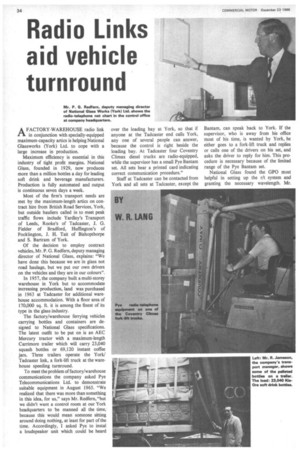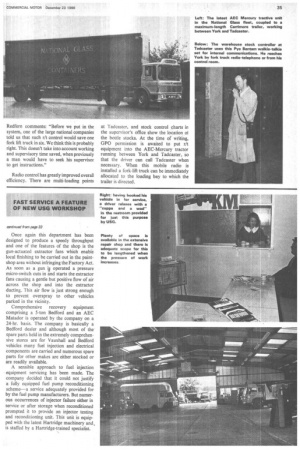Radio Links aid vehicle turnround
Page 36

Page 37

If you've noticed an error in this article please click here to report it so we can fix it.
AFACTORY-WAREHOUSE radio link in conjunction with specially-equipped maximum-capacity attics is helping National Glassworks (York) Ltd. to cope with a large increase in production.
Maximum efficiency is essential in this industry of tight profit margins. National Glass, founded in 1929, now produces more than a million bottles a day for leading soft drink and beverage manufacturers. Production is fully automated and output is continuous seven days a week.
Most of the firm's transport needs are met by the maximum-length artics on contract hire from British Road Services, York, but outside hauliers called in to meet peak traffic flows include Yardley's Transport of Leeds, Rooke's of Tadcaster, J. G. Fielder of Bradford, Huffington's of Pocklington, J. H. Tait of Bishopthorpe and S. Bartram of York.
Of the decision to employ contract vehicles, Mr. P. G. Redfern, deputy managing director of National Glass, explains: "We have done this because we are in glass not road haulage, but we put our own drivers on the vehicles and they are in our colours".
In 1957, the company built a tnulti-storey warehouse in York but to accommodate increasing production, land was purchased in 1963 at Tadcaster for additional warehouse accommodation. With a floor area of 170,000 sq. ft. it is among the finest of its type in the glass industry.
The factory/warehouse ferrying vehicles carrying bottles and containers are designed to National Glass specifications. The latest outfit to be put on is an AEC Mercury tractor with a maximum-length Carrimore trailer which will carry 23,040 squash bottles or 69,120 instant coffee jars. Three trailers operate the York/ Tadcaster link, a fork-lift truck at the warehouse speeding turnround.
To meet the problem of factory/warehouse communications the company asked Pye Telecommunications Ltd. to demonstrate suitable equipment in August 1965. "We realized that there was more than something in this idea, for us," says Mr. Redfern, "but we didn't want a control room at our York headquarters to be manned all the time, because this would mean someone sitting around doing nothing, at least for part of the time. Accordingly, I asked Pye to instal a loudspeaker unit which could be heard over the loading bay at York, so that if anyone at the Tadcaster end calls York, any one of several people can answer, because the control is right beside the loading bay. At Tadcaster four Coventry Climax diesel trucks are radio-equipped, while the supervisor has a small Pye Bantam set. All sets bear a printed card indicating correct communication procedure."
Staff at Tadcaster can be contacted from York and all sets at Tadcaster, except the Bantam, can speak back to York. If the supervisor, who is away from his office most of his time, is wanted by York, he either goes to a fork-lift truck and replies or calls one of the drivers on his set, and asks the driver to reply for him. This procedure is necessary because of the limited range of the Pye Bantam set.
National Glass found the GPO most helpful in setting up the r/t system and granting the necessary wavelength. Mr. Redfern comments: "Before we put in the system, one of the large national companies told us that such r/t control would save one fork lift truck in six. We think this is probably right. This doesn't take into account working and supervisory time saved, when previously a man would have to seek his supervisor to get instructions."
Radio control has greatly improved overall efficiency. There are multi-loading points at Tadcaster, and stock control charts in the supervisor's office show the location ol the bottle stocks. At the time of writing, GPO permission is awaited to put et equipment into the AEC-Mercury tractor running between York and Tadcaster, so that the driver can call Tadcaster when necessary. When this mobile radio is installed a fork-lift truck can be immediately allocated to the loading bay to which the trailer is directed.












































































